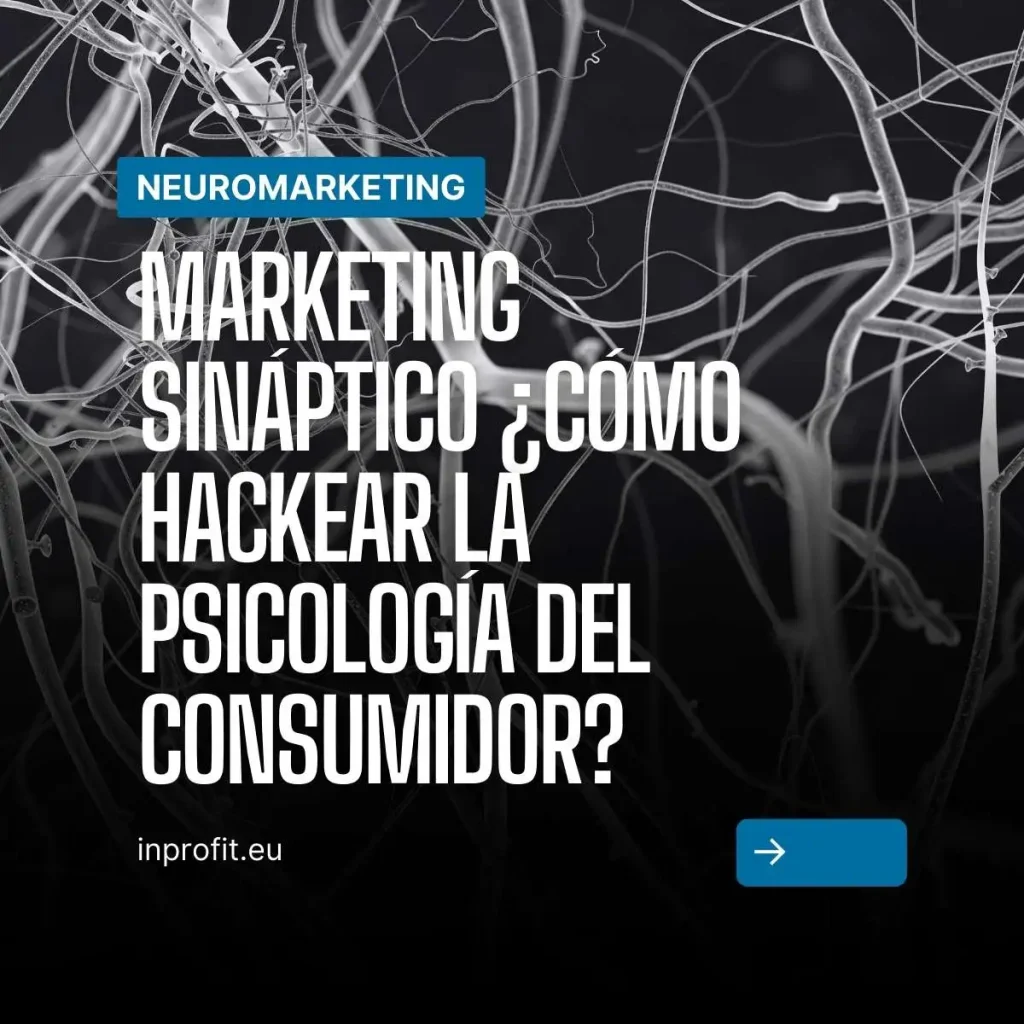Neuromarketing combines neuroscience, psychology and marketing to understand how the human brain responds to commercial stimuli. Unlike traditional marketing, which relies on surveys and focus groups, neuromarketing uses advanced technologies to measure physiological and brain responses, revealing what consumers really feel, even when they are not aware of it.
In an information-saturated world where consumers are bombarded with ads, brands need to stand out. This is where synaptic marketing comes into play: a strategy that “hacks” neural connections to create messages that resonate on an emotional and subconscious level. But how do companies achieve this level of connection? The answer lies in emerging technologies.
Top Technologies in Advanced Neuromarketing
Neuromarketing relies on cutting-edge technological tools that allow marketers to analyze data that was previously inaccessible. Below, we explore the most relevant ones:
1. Brainwave Analysis
Electroencephalogram (EEG) measures the electrical activity of the brain, allowing specialists to identify emotions such as pleasure, attention or stress during interaction with an advertisement or product. This technology is key to understanding which elements of a campaign generate a positive emotional response.
For example, an EEG study can show whether a TV ad activates areas of the brain associated with reward, helping marketers optimize content to maximize emotional impact.
2. Tracking of Facial Microexpressions
Microexpressions are involuntary facial movements that reveal authentic emotions in fractions of a second. Highly sensitive cameras and artificial intelligence software can analyze these expressions to determine how a consumer feels about an advertising stimulus. For example, a fleeting smile may indicate delight, while a frown may signal rejection.
Biometric Sensors
Biometric sensors measure physiological responses such as heart rate, skin conductivity (sweating) and pupil dilation. These metrics provide objective data on a consumer’s level of arousal or stress, allowing brands to tailor their messaging to generate positive emotions.
4. Eye-Tracking
Eye tracking reveals which parts of an ad or web page capture the consumer’s attention. This technology helps optimize the visual design of campaigns to ensure that key elements are the most prominent.
How to interpret emotional data to create irresistible messages?
Neuromarketing is not only about collecting data, but also about interpreting it correctly to design campaigns that connect at a subconscious level. Here’s how to do it:
Identify key emotions
The human brain is programmed to respond to emotions such as fear, happiness, surprise and trust. Using EEG data and biometric sensors, brands can identify what emotions their content triggers and adjust to maximize impact. For example, an ad that generates high activation in the reward areas of the brain is more likely to encourage brand loyalty.
2. Subconscious personalization
Neuromarketing allows you to personalize messages based on the emotional responses of specific audience segments. For example, a study of microexpressions may reveal that one demographic responds better to warm colors, while another prefers neutral tones. This information allows the creation of hyper-personalized campaigns.
Simplifies decision making
The human brain prefers simple decisions. Eye-tracking data can show if a design is too complex, causing confusion or disinterest. Simplifying visual and textual elements based on this data can increase conversion rates.
4. Create emotional narratives
Stories that connect emotionally with the consumer are more effective. For example, an ad that uses images of happy families can activate areas of the brain associated with security and love, generating a stronger connection with the brand.
Practical examples in action
Major brands are already using neuromarketing to optimize their campaigns. For example:
- Coca-Cola: Used EEG to measure brain responses to different versions of its holiday ads, finding that images of families together generated greater emotional activation than product-focused ads.
- Nike: Through the analysis of microexpressions, Nike optimized its sports motivation campaigns, using phrases and colors that generate a response of enthusiasm and empowerment.
- Amazon: The e-commerce giant employs eye-tracking to design user interfaces that guide consumer attention to purchase buttons, increasing conversions.

Why is Neuromarketing your business superpower?
Neuromarketing is not just a tool, it’s a superpower that transforms the way brands connect with their audiences! Here’s how this approach can catapult your strategy to the next level:
- Conquer your audience’s heart: By understanding subconscious emotions, you can create campaigns that are not only seen, but felt. It’s like having a direct key to the soul of your consumers, generating loyalty that lasts.
- Maximize every euro invested: With accurate data on what works and what doesn’t, say goodbye to failed campaigns. Neuromarketing allows you to focus your budget on messages that really make an impact, boosting your return on investment (ROI) like a rocket.
- Anticipate: While your competitors are relying on assumptions, you will have brain and physiological data that will give you a strategic advantage. It’s like reading the market’s mind before they even know what they want.
- Create unforgettable experiences: From an ad that quickens the pulse to a web design that catches the eye, neuromarketing allows you to design experiences that stick in consumers’ memories.
Navigating the shadows of Neuromarketing
Every superpower comes with a responsibility, and neuromarketing is no exception. Delving into the consumer’s subconscious can be fascinating terrain, but it’s also full of shadows that you must navigate with care:
- The ethical dilemma: Is it right to influence subconscious decisions? Neuromarketing can appear to be a double-edged sword if not used transparently. Brands must prioritize trust, ensuring that their tactics respect consumer privacy and autonomy.
- The cost of entry: Equipment such as EEG or biometric sensors are not cheap, and mastering their use requires time and talent. It’s like embarking on an expedition into the human brain: exciting, but with an upfront cost that can be intimidating for smaller companies.
- The risk of misinterpretation: Neuromarketing data is powerful, but misinterpreted it can lead to failed strategies. It’s like reading a star map without knowing astronomy: you need experts to translate the signals into effective actions.
- Exaggerated expectations: Neuromarketing is not magic. While it can give you an edge, it doesn’t guarantee instant success. Brands must combine it with creativity and strategy to unleash its full potential.
Trends for 2025
Neuromarketing is constantly evolving, and trends for 2025 include:
- Advanced Artificial IntelligenceAI will improve the interpretation of neuromarketing data, enabling faster and more accurate analysis.
- Virtual Reality (VR): Immersive VR experiences will allow brands to study emotional responses in simulated environments.
- Wearables Neuromarketing: Wearable devices with integrated biometric sensors will provide real-time data on consumer emotions.
- Predictive AnalyticsPredictive algorithms will combine neuromarketing data with big data to anticipate buying behavior.
How to implement Neuromarketing in your strategy?
If you want to incorporate neuromarketing into your marketing strategy, follow these steps:
- Invest in Technology: Acquire tools such as EEG, micro-expression cameras or eye-tracking software.
- Collaborate with Experts: Work with neuroscientists and data specialists to interpret results.
- Pilot Test: Before launching a large-scale campaign, test your ads on a small group using neuromarketing techniques.
- Adjust and Optimize: Use the data obtained to refine your messages and designs.
- Measure the Impact: Evaluate the ROI of your neuromarketing campaigns to justify the investment.
The power of synaptic marketing
Advanced neuromarketing is revolutionizing the way brands connect with their consumers. By using technologies such as brainwave analysis, micro-expression tracking and biometric sensors, companies can create campaigns that not only capture attention, but generate deep and lasting emotional responses. In a competitive marketplace, synaptic marketing is the key to hacking consumer psychology and building authentic relationships with the audience.
Are you ready to take your marketing strategy to the next level? Neuromarketing is the path to the future of targeted shopping, learn more now.



